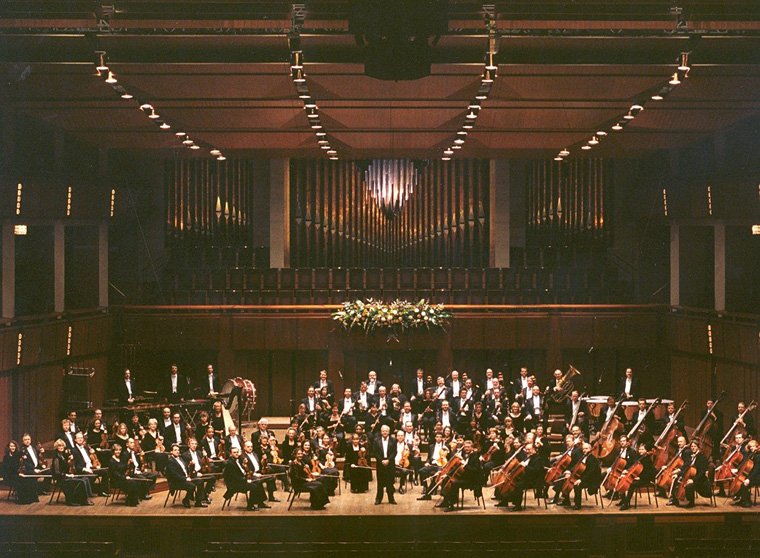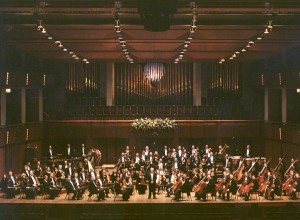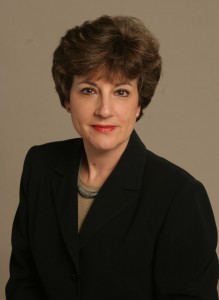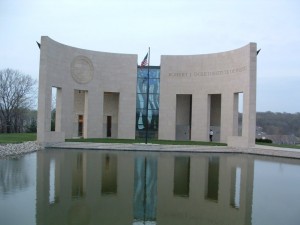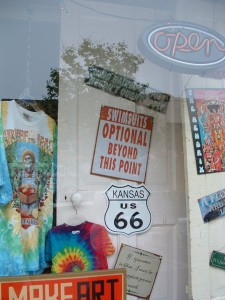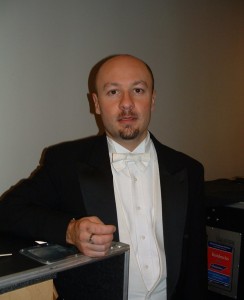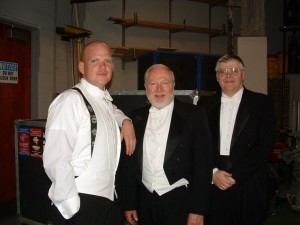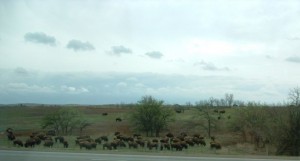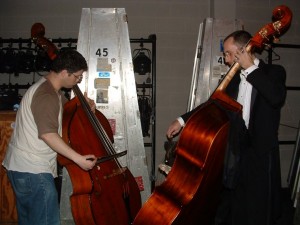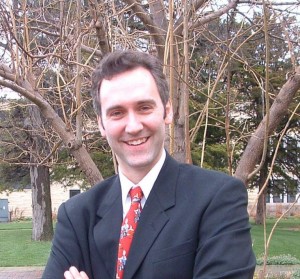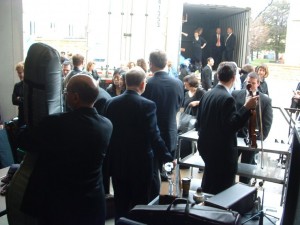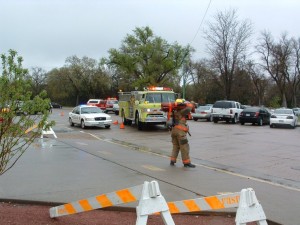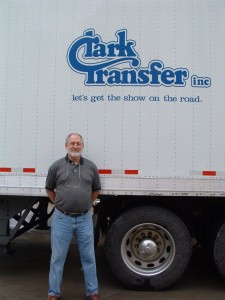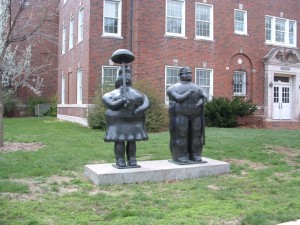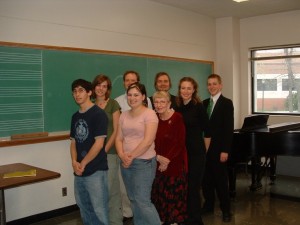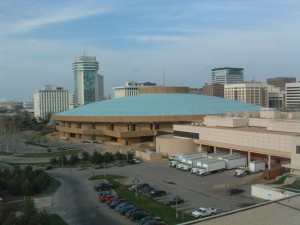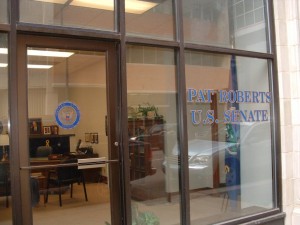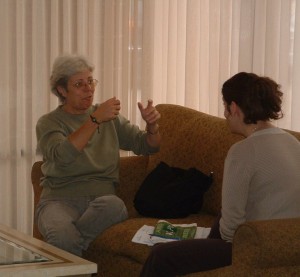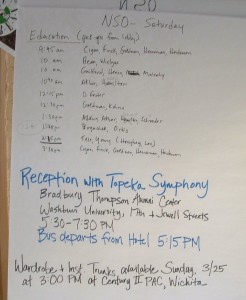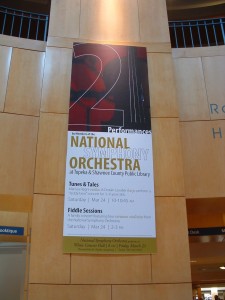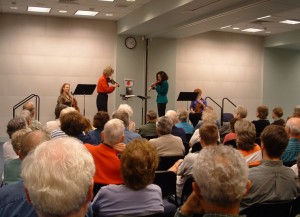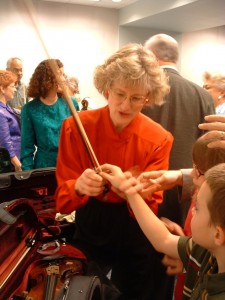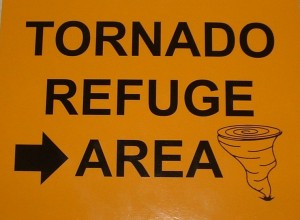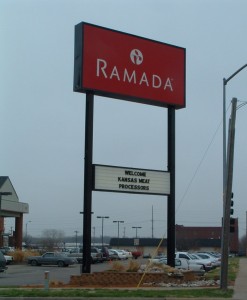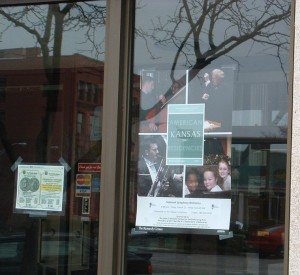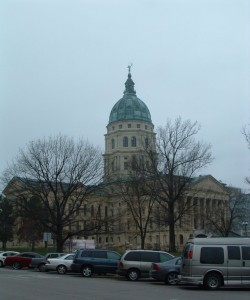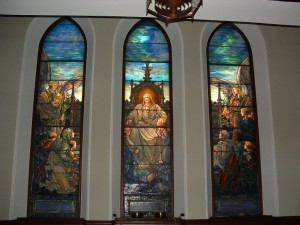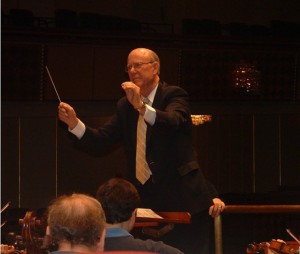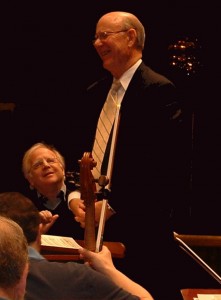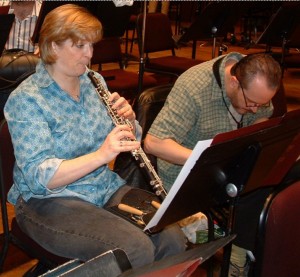National Symphony Orchestra
About the Ensemble
Click the Day 4 button above to view the NSO’s postcards from their recent Residency in Kansas.
The National Symphony Orchestra of Washington (NSO) was founded in 1931 by Hans Kindler (a cellist). The goal was to create an orchestra worthy of the nation’s capitol. We still want to be the orchestra of our great city, but we also strive to live up to the “national” part of our name.
There have only been a handful of music directors for the orchestra: after Hans Kindler came Howard Mitchell (a cellist), then Antal Dorati, Mstislav Rostropovich (another cellist!) and our current Music Director, Leonard Slatkin. The orchestra is currently seeking a new music director, as Maestro Slatkin is leaving at the end of the ‘07-‘08 season.
In 1971 the NSO moved to its current home, the Concert Hall of the John F. Kennedy Center for the Performing Arts, and in 1986 became officially affiliated with the Kennedy Center, a financial move that benefited both organizations.
There are several things that make the NSO unique among American orchestras. You might have seen us on TV for our annual Memorial Day concert at the Capitol, or our annual 4th of July concert, our most visible national presence. You might not have heard about our yearly American Residency, sponsored in part by the US Department of Education. The first Residency took place in Alaska in 1992, and the NSO has continued with this project each year since. In March 2007 the orchestra will visit Kansas, our 18th state, and I’ll be sending “postcards” to Polyphonic, highlighting some of our activities while we’re there. During the nine days we will be in Kansas, we have about 120 activities scheduled – from orchestra concerts to chamber music concerts, master classes and clinics, workshops, lectures, and in-school presentations.
Another project unique to the NSO is Leonard Slatkin’s National Conducting Institute. Each year the NSO devotes significant time to working with young conductors chosen by Leonard. The conductors work with members of our staff to learn about the responsibilities of a music director, whether it’s understanding marketing, choosing programs for the orchestra, or talking with the board about finances. We have rehearsals and concerts with the conductors, with both Leonard and the musicians providing helpful feedback to them.
These are exciting times for the NSO. There’s a lot going on here in Washington, and we are a vital part of it.
Yvonne Caruthers, Senior Editor, March 2007
Interview with Rita Shapiro, Executive Director of the NSO since August 2002
Yvonne Caruthers: What made you come to the NSO?
Rita Shapiro:It was really a case of being in the right place at the right time.My family had relocated to the DC area because my husband began a new position as director of choral activities at the University of Maryland. I had left the Cleveland Orchestra after 12 years as their operations manager. As the NSO is part of the Kennedy Center, the nation’s performing arts center, it gave the job a unique spin and some interesting challenges.
YC: You’ve had experience with other orchestras…how is the NSO different?
RS:My first orchestra position was as a fundraiser for the Boston Symphony, which gave me a grounding in donor relations and cultivation. As operations manager with the Cleveland Orchestra, I was responsible for leading tours to the great concert halls of Europe, Asia and the US. Now as head of the National Symphony, my responsibilities are more wide-ranging. Here in Washington we perform for audiences including students of all ages; to devoted long-time subscribers from diverse backgrounds; to members of the diplomatic community and members of Congress. We also take our national mission seriously, thinking of ways we can reach out andengage constituencies around the country. One of the best ways we do this is through our American Residencies program. Many orchestras do significant outreach in their communities, but we are the only orchestra in the US with a long-term strategy to visit different states and form partnerships with orchestras around the country.
YC: Partnerships with other orchestras? How does that happen?
RS:When we identify the state for a future residency, our first approach is to the state arts council. We coordinate our activities through them, asking them to contact both major and regional orchestras throughout the state to see if they are willing to present us in their halls. We don’t ask for any performance fees, so the benefit for the local orchestras who present us is that they get to keep all the revenue from ticket sales to our concerts.
In addition to full orchestral concerts, we will usually perform about 125 other free activities in a 9-day residency, including student and family concerts, master classes, coachings, chamber music concerts, arts advocacy talks, Suzuki workshops, performances in retirement homes and community centers, etc. We’ve learned that often after our residency is completed, there is typically a spike in sales for the local orchestra. That’s one of the main goals of the program – to help build audiences for classical music in venues of all kinds across the country, and to support the work of orchestras in the states we visit.
YC: How can the NSO afford this?
RS:We are partially supported by the Kennedy Center through a grant from the Department of Education, the Abe Fortas Memorial Fund for Chamber Music – which underwrites the chamber music component of the residency, and we do private fundraising, which varies from state to state. In Kansas for this year’s residency we are receiving support from Koch Industries and the Fred C. and Mary R. Koch Foundation. We feel we’ve done well if we can simply break even, which is not always the case. Even when we don’t break even, we continue the project because we’ve made an institutional commitment to this program.
YC: Can you describe one of your pet projects?
RS:One of my current favorites is the NSO Forum, which we launched recently. It came out of a cross-constituency group that we put together for a special event: we invited board members to sit onstage for a special orchestra rehearsal. Before this event took place, we did some brainstorming, and one of the ideas (from a board member) was to set up an online discussion group. We keep it focused on artistic topics, and it’s been interesting to observe the questions and comments that bounce back and forth between board members and musicians. I’ve been trying to connect board, musicians, and staff in more meaningful ways than the usual cocktail parties or receptions.
YC: What are you most proud of accomplishing since you arrived?
RS:We’ve had some good experiences bringing our constituencies together through strategic planning conversations on education and community engagement, and with the ongoing music director search. I want to keep those dialogues going. Many of the best ideas come from our musicians, and we need to continue to create working groups that get those ideas out, and have open discussions with all the right people in the room.
YC: What do you see that’s new coming in the next 3-5 years?
RS:When a new music director is appointed, there will be a natural opportunity to try some new things. We want to attract new audiences, and still retain our loyal subscribers. I think that the key lies in more flexibility about some of the ways we accomplish these and other goals. We need to take some risks, not just in the choice of music that we play, but with the kinds of programs we engage in. For example, we are focusing now on strategies to get us more routinely into parts of the Washington, DC community we haven’t yet reached. How can and should we use the orchestra’s time to accomplish that, now and in the future? Musicians, board and staff all need to be part of the dialogue.
YC: What do you see for the future of large orchestras?
RS:I don’t claim to have all the right answers, but I believe it’s short sighted to think that all orchestras – large or small – can sustain “business as usual” forever. We have to get far more creative than playing classical concerts in the traditional model of three subscription concerts per week. First and foremost is maintaining the quality of performances. If we’re not making consistently great and compelling music, we’ll lose the loyalty of our audiences. But I believe along with sustaining quality, we have to find ways to be flexible, to adapt to a changing audience, so we will need to experiment with our formats and subscription packaging.
We should continue to look at the ways we engage our audiences through a variety of means. Multimedia presentations, prepared materials delivered in advance electronically, speaking from the stage, etc. are all being tried these days, with varying degrees of success.I think we need to keep a “balanced portfolio” but find ways to attract people to the concert hall who are curious about classical music but aren’t yet regular concertgoers, and give them a great reason to want to come back. All of us in the orchestra business need to become involved in this process of audience cultivation.
Interview with Carole Wysocki, Director of Education Programs for the NSO

Carole Wysocki, right, confers with Kate Preston, assistant production manager, about logistics for the upcoming Kansas residency. Photo Credit: Yvonne Caruthers
(We began with a few statistics.)
Yvonne Caruthers: Our first residency?
Carole Wysocki:Our first residency was in 1992, when we went to Alaska. In 2007 we are visiting our 17th state, which is Kansas.
YC: What was that first year like?
CW:We only did 75 events that first year and we really had no idea what we were doing…we played orchestra concerts, but we had so many requests to go into schools, and to play chamber music concerts (our players were flown to remote towns by plane), so our challenge was to find/make products that would be acceptable to schools and be educationally sound. For our second residency, in Louisiana, we had 175 events. We had over-scheduled because we were over-exuberant. That nearly killed us!
YC: How many events are we doing this year in Kansas?
CW: We have about 120 events. Approximately 56% of the orchestra is participating this year, which is a pretty striking statistic. Everyone who participates in activities besides orchestra concerts is doing so because they choose to.
YC: You’ve been involved in the residencies since the first year. What was the impetus behind starting this program?
CW:It was actually [former head of the Kennedy Center] Mr. [James] Wolfensohn’s idea with Sen. Ted Stevens. Mr. Wolfensohn wanted the Kennedy Center and the NSO to live up to the “National” part of our name. He came to the NSO staff and said, “I have a state, what can you come up with?”
YC: Did you have a state arts contact in Alaska?
CW:We had a concert association, with representatives from the Anchorage, Fairbanks, and Juneau areas.
YC: Do you still use the same process today? What have you learned?
CW:We require the state to hire a contact—it’s the only cost to the state. We need one coordinator for the entire state, and that person forms a committee to help them. It’s the best way to cover all regions of a state.
YC: Can you describe the whole process of preparing for the residency for us?
CW:About 18 months in advance, our operations team determines what concert halls and hotels will serve the NSO’s needs. A consortium of large arts associations in the state helps decide how everything will happen. I send along with the pre-tour folks a list of activities that we offer, including definitions, so that everyone understands the difference between a clinic and a master class, etc. The state contact sends out our list for everyone to look at, and a short time later collects requests from the state.
The requests are prioritized and sent back to me. I get them about 4-5 months before our residency. The staff and I check the feasibility of each request (e.g., is there time in the NSO schedule to get our players to each town? Will there be food available? Does the request fit one of the activities we offer?). I post all the requests (along with the residency itinerary) for the NSO musicians, and players begin signing up for the activities they are interested in. I confirm the requests with the players and with the contacts in our residency state, and the last step is to draw up the final list and all the contracts.
YC: When we finally get to Kansas…
CW:Surprisingly there’s very little mayhem—after all these years I can sense problems before they happen. The only thing we haven’t been able to solve is the difference between what we think we’re going to do and what is actually expected when we get there….those aren’t always the same thing. When a group has been told to meet a class of fifty 3rd graders and instead find a K-12 school assembly….well, what can you do?
YC: Let’s talk about funding for the Residencies.
CW:Over the years we’ve had NEA grants to visit “underserved states,” so those states were on our list. We have Department of Education funds and sometimes we even have sponsors. This year the state of Kansas got a grant from Koch Industries, based in Wichita, KS. As is typical for our residencies, all money made from concert ticket sales will remain in the state to benefit local arts organizations. We’re fortunate that we have Department of Education funding. We can’t cover our costs; the Kennedy Center helps us.
YC: Why does the KC help?
CW:Michael Kaiser, the current head of the Kennedy Center, believes it’s the national mandate of the nation’s performing arts center.
YC: Can you tell us about other programs related to the Residency?
CW:We have three enrichment programs.
1) From the first year we had our Summer Music Institute as an extension of the residency. Up to 6 students from our residency state may be invited to our annual four-week summer program, which is an all-expenses-paid program.
2) We have a composer-commissioning program. Any composer who has resided in the state for at least three years may submit one of their compositions. Based on that entry, the winning composer can be commissioned for a chamber music piece to be played by NSO musicians in the Kennedy Center.
3) And we have a teacher fellowship. Chosen by the residency organization, that teacher comes to the Kennedy Center for four weeks in the summer to better themselves as a musician and to improve their teaching. They help plan their own course of study with us.
YC: Do you have advice for other orchestras who might contemplate doing a residency?
CW:Yes: don’t impose anything on the state. We don’t come in like “know it alls, or done it alls”….each state is different. Our list says what we can do, but the localities choose what they want. If they already have an orchestra that does a lot of youth concerts, they can choose something else, maybe master classes for college students. If the state has no large orchestra and has trouble reaching students, they might request more of our in-school ensembles. By the way, almost everything we do on the road has first been tested in Washington, DC, prior to leaving. The communities we visit aren’t our “guinea pigs.”
YC: We don’t do follow-up….do you regret that?
CW:We really wish we could, especially in states where so many kids don’t have access to regular lessons. I think the best way to stay in touch would be with follow-up master classes. We wish we could meet the people we’ve met via something like Internet2, but at this point something like that is too labor intensive for us.
YC: Do you think the residencies have long-lasting effects?
CW:Believe it or not, we still hear stories from Anchorage, our very first visit. Also, some folks in NC hired our consultant (Gary Race) to help them prepare to present in-school ensembles….so we know we had an impact!
Postcards from the NSO’s Residency in Kansas
We’re all home safely from our trip. After the space and quiet in Kansas, it’s a bit of an adjustment to be back in DC with the Cherry Blossom Festival in full swing – crowds everwhere, lots of extra traffic – we have to get used to all this again.
I was happy to read a grateful comment from a woman in Pittsburgh KS, so I think I’ll let her have the last word. –Yvonne
“I would like to thank you for including a small venue in with your touring schedule in Kansas. I took my 10-year-old son Nic to last night’s performance in Pittsburgh. He had a terrific experience. Thank you for the opportunity to share such a beautiful cultural experience with my child.”
Delaine Robinson
Wednesday, March 28, Lawrence KS
Lawrence is a study in contrasts, from the Robert J. Dole Institute for Politics (on the left) to the downtown area, which is full of eclectic shops and ethnic restaurants. The store window below is typical.
However, there is a strong music program in many of the schools, and our players were happy to interact with them.
Laurent Weibel worked with the students of Alice Joy Lewis, a noted Suzuki teacher. One student, aged 13, played the Franck sonata so well that Laurent was really taken aback.
Rick Barber and Glenn Donnellan (who were both pictured yesterday) worked with a group of 200 high school kids. They were pleasantly surprised to find a school with 70-80 string players in an orchestra. Rick told me that it’s always a personal challenge for him to work with such a group. The kids start off being reluctant to ask questions, but by the end of the session they literally have to be told to leave for their next class!
The brass quintet has been busy on this Residency, so I asked three of them (pictured here: Tom Cupples, 2nd trumpet; Milt Stevens, principal trombone; and Steven Hendrickson, principal trumpet) during the intermission at tonight’s concert how their concerts have been going. They’ve been impressed that most of the schools they’ve played for have strong music programs.
Steve Hendrickson told me what a surprise it was for him to give clinics in Wichita and Manhattan (KS) and to discover that the trumpet teachers at those colleges used to be his students, back in the days when he, Steve, was struggling to make ends meet in Chicago.
Last of all, I spoke to Rebecca Henderson, our substitute principal oboist. She told me how much she had enjoyed playing in retirement homes in Topeka with the woodwind quintet. This was her first-ever Residency and she really enjoyed the chance to meet people in the communities, not to “just play concerts.”
Tuesday, March 27, Hays KS
First of all, it’s Slava’s 80th BD today and many of us wished him a happy birthday. We hope his health continues to improve.
Hays KS is about a 3 hour drive from Wichita, where we started yesterday morning. It’s a 4 hour drive from Lawrence, where we’ll be this evening. It’s also been the place we’ll all remember from this trip.
From the bus window yesterday it was exciting to see a herd of buffalo.
Our concert last night (Monday, March 26th) was not well attended, but we suspect it could have been because the publicity listed it as beginning at 8pm, when in fact it began at 7:30. Here you see Jeff Weisner and Rick Barber warming up backstage before the concert.
This morning we had a children’s concert at 9:45, and we started a few minutes late to get everyone in—the hall was nearly full. About halfway through the program we play Leroy Anderson’s Fiddle Faddle, so violinist Glenn Donnellan demonstrates for the students the difference between playing the violin and playing the fiddle.
We were about a minute into Fiddle Faddle when the fire alarm went off. At first we kept playing, thinking it had to be a false alarm. The horn kept blaring, so Associate Conductor Emil de Cou motioned for us to stop. We sat there for another minute, not knowing what to do. When we saw a few students begin to evacuate we knew it was time to leave the stage. Once offstage we were told there was a fire in the basement, and that we should put our instruments in cases and leave the building.
In less than a minute the fire department arrived.
The fire was quickly put out and after about fifteen minutes, we were allowed to go back in the building to pack our instruments in their trunks and change out of our concert clothes.
Of course we’re making jokes about it now, but it’s the first time in my career that I’ve been asked to evacuate the hall during a concert.
We’re now on the bus, headed back to Lawrence KS. Our instruments and our wardrobe trunks are on “the truck,” which is driven by Ron Moore, who has been driving “the truck” for the NSO for as long as I can remember. Ironically, one of his sons is a trombone player in college, and hopes to become a professional player in a few years.
Monday, March 26, Wichita KS
We had a long drive from Topeka to Wichita. I grabbed a quick lunch, did a bit of practicing, and then I was met by Jakub Omsky, the cello teacher at Wichita State University. Jakub drove me to campus and showed me some of the many pieces of modern art, including the Botero sculptures pictured here. I’m starting to think that Kansas should bill itself as a fine arts destination!
The cello class at WSU, pictured to the right, was technically on their last day of spring break, but three of them played for me anyway. I heard works by Bach, Kodaly, and Dvorak. It’s always inspiring to hear young adults working so hard, and we had a terrific afternoon together. Jakub Ormsky is 3rd from the right in the back row.
The concert hall in Wichita is part of the Century II performing arts complex. It’s attached to the hotel we stayed in, so it was nice to be able to walk to the concert. Viewed from the hotel, the complex vaguely resembles a UFO. Inside, it’s absolutely huge, with the space divided up into several halls that can be reconfigured to fit just about any size.
Senator Pat Roberts conducted Stars and Stripes as an encore again for us…he’s showing great promise as a conductor!
This morning I walking around downtown Wichita and passed Sen. Roberts’ office!
Sunday, March 25, Topeka KS
Facing you in the photo on the left is Jeen Fedelich, the travel planner who makes all our tours go smoothly. We used to only see her when we were in Europe, but she now works for the company Classical Movements, which handles virtually every orchestra’s tour to anywhere. Jeen is the woman who stays a day ahead of our schedule and keeps problems from ever happening.
The way we keep track of the daily schedule is by consulting the bulletin board in the hotel lobby.

Fiddle Sessions: Elizabeth Adkins (associate concertmaster), Linda Schroeder, Jane Stewart, and Paula Akbar
Last night at our Topeka concert one of our violinists, Holly Hamilton, became very ill and returned to the hotel. She’s still sick today and a group she was scheduled to play in had to find a replacement, so violinist Jane Stewart stepped in (luckily Jane has played the repertoire before!) The group of four violinists presented a program called “Fiddle Sessions” at the Topeka and Shawnee County Public Library. They played a concert of arrangements for 2, 3, and 4 violins, ranging from Bartok duos to a Telemann concerto.
What a nice welcome! There was a huge poster in the atrium announcing one of our concerts yesterday, and the violin concert today. This is not your ordinary library—their host explained that it’s 5 years old, has 168,000 sq ft, 174 computers (seemingly all in use), and is visited by about 3,000 people per day (from a town of approx. 180,000). There is a café in the library, a bookshop, and an art gallery. The art gallery was hosting a national, juried competition of three dimensional art works.
During the Fiddle Music concert, Linda Schroeder and Jane Stewart demonstrated table music—both players reading the same music from opposite sides of a music table.
They got a standing ovation and took many questions from the audience of about 100 people.
These personal encounters are what make our Residencies so rewarding.
Saturday, March 24, Topeka KS
Last night the NSO played its first concert of our Kansas Residency at White Concert Hall on the Washburn University campus. Bill Blankenship of the Topeka Capital-Journal reviewed the concert and wrote:
“… the proud-to-be-an-American-watching-America’s-symphony moment came right before intermission when Slatkin led the NSO in playing Aaron Copland’s suite from the ballet Appalachian Spring. When it comes to American composers, Copland is to orchestral works what John Philip Sousa is to marches. So when the expressive Slatkin cued the passage when the Shaker hymn Simple Gifts swells from simple humility to orchestral grandeur, it was a moment no one in the audience will soon forget.” Just as we had rehearsed, Sen. Pat Roberts made his NSO debut conducting Stars and Stripes for an encore. The hometown loved it!
Among today’s activities for the NSO are the following:
- 10 to 10:45 AM: “Teddy Bear Concert,” by a violinist and harpist, for 3-to-6-year-olds, in Marvin Auditorium, Topeka and Shawnee County Public Library, 1515 S.W. 10th. Youngsters are encouraged to bring their teddy bears.
- 1 PM: Trombone trio plays at Barnes & Noble, 6130 S.W. 17th.
- 2 to 3 PM: A violin quartet presents “Fiddle Sessions: A Family Concert” in the library’s Marvin Auditorium.
- 3:30 to 4:45 PM: “Four in Correspondence,” a cello quartet, plays at Temple Beth Sholom, 4200 S.W. Munson, then answers audience questions.
This sign caught my eye at the concert last night.
Thursday, March 22, Topeka KS
It’s in the 50s, overcast, and there’s a cool breeze. Half of the orchestra had an early flight out of Washington; the other half is in transit as I write. They’ll arrive in Topeka this evening. Tomorrow we begin our Residency activities, but today we had time to be tourists.
Our hotel has a welcome sign out, but it’s not for us!
Luckily, as I walked around town I also spotted one of the NSO’s posters in a bank window.
Topeka is the capitol of Kansas, and the statehouse dominates the center of the city.
One thing I love about our Residencies is discovering local treasures. Topeka has a church with original Tiffany stained glass windows. The First Presbyterian Church is across the street from the statehouse and its windows are magnificent! (The ones pictured here are only a small part of the collection.)
Tuesday, March 20, Washington DC
Here’s our first postcard and we haven’t even left for Kansas yet!
Today we had our last rehearsal before we depart. Leonard Slatkin had asked Kansas Senator Pat Roberts to rehearse with us here in Washington (easier logistics, more time available), so we started our rehearsal with the Senator conducting Stars and Stripes (one of our encores in KS, which the Senator will conduct).
The first photo shows the Senator “in action,” and the second one shows Leonard giving a few helpful hints. Read Senator Roberts’ Journal about the NSO’s Residency
Other developments of interest: Our 2nd clarinet player, Paul Cigan, is not able to make the trip with us because doctors discovered a blood clot in his leg. He’s going to stay home and his wife, Terri, also a clarinetist, is taking his place. Terri is not a member of the NSO but has regularly subbed with us. How many families could pull that off?
Our principal oboist, Rudy Vrbsky, also will not be traveling with us as his wife fractured her ankle last weekend. We have a wonderful oboist, Rebecca Henderson, who has been playing with us on a one- year contract as assistant principal. She took leave from UT Austin to come to Washington and it’s been a real pleasure working with her. She was asked only a couple of days ago to fill in as principal oboe for the Residency. Our repertoire for the trip is Walton: Partita for Orchestra; Copland: Appalachian Spring; Schubert: Unfinished Symphony; and Ravel: Suite No. 2 from Daphnis and Chloe. I got a photo of her after rehearsal (to Rebecca’s left is oboist Bill Wielgus).

